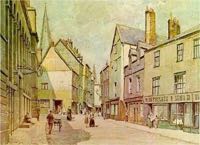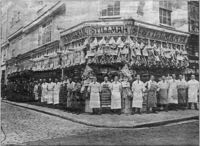
Guinea Street
Page updated 31st January 2016
 Most
of this little street disappeared when the
buildings around the old Lower Market were destroyed in the bombing of
May 1942. There is a small passageway between South Street and George
Street which is roughly where Guinea Street joined South Street. The
street dates back to the time of Henry II - the name comes from the
ancient word ginnel or gennel for narrow passage way.
Most
of this little street disappeared when the
buildings around the old Lower Market were destroyed in the bombing of
May 1942. There is a small passageway between South Street and George
Street which is roughly where Guinea Street joined South Street. The
street dates back to the time of Henry II - the name comes from the
ancient word ginnel or gennel for narrow passage way.
The West Quarter was the poorest area of Exeter and had social deprivations worse than many other parts of Britain. During the last days of the cholera outbreak in August 1832 the Improvement Commission discussed building sewers in Guinea and other local streets. They worked quickly, for a month later both Guinea Street and Idle Lane had sewers laid.
The deprivation of the area encouraged prostitution - probably the worst place during the 1840's was the Pestle and Mortar in Guinea Street. It provided lodgings 'for persons of the lowest class'. In 1839, the superintendent of police was instructed 'not to permit prostitution, nightwalkers or other disorderly persons to loiter in public streets or footway.'
Pubs
Fleur de Luce:—A reference in the Sherborne Mercury of 1756 stated it was "by which is a passage into the butcherow". In 1791, Robert Wreford purchased the inn from Sophia de Vial—her name may reflect the French name of the inn. A fleur de luce is a perennial herb. The inn may have also been known as the Golden Lion.
(New) Golden Lion:—This may have been the Fleur de Luce in the late 18th century. It was a lively house in the 19th century, with many references to the police attending for late hour drinking and drunkenness. It was also used for land and building auctions. Destroyed by fire in the May 1942 blitz
Market House Inn:—The earliest reference was in 1822. In September 1838, it was announced that "The Exeter Western Conservative Association will hold their next quarterly meeting on Monday, the 1st October at Tapper's Market House Inn, Guinea-street" In September 1841, it was for let "This Inn is well known, and is frequented by most respectable Yeoman on Market Days" with Mr John Holman in occupation. By January 1846, Mr William Burcher opened the Albert Saloon at the inn "where a pianist, and several professional singers nightly attend" The entertainment cannot have been good for business because G L Tancock took the inn during April 1846. In 1850, a case of theft of a silver spoon belonging to T L Tancock appeared at the Guildhall. The last listing in a directory was in 1851 and it seems to have disappeared. In 1917, the premises were occupied by Burgess & Sons.
Pestle and Mortar:—This snippet appeared in the Western Times of 1842. "A man named Burroughs, landlord of the Pestle and Mortar, Guinea-street (against whom repeated keeping disorderly house have lately been preferred), was brought up charged with stealing five sovereigns from the person of a poor Lascar, named Abraham Bowkiss, a native of Hindostan." Is this the first reference to someone from north-west India being in the city? This is the only reference to this house in the newspapers.
Royal Oak:—This establishment was first listed in a street directory in 1816. It was recorded as a cellar, stable, storehouse and garden in the Parish of St George bounded by Preston Street and Smythen Street when it was purchased by Harding and Richards in 1821. Last listed in 1897. It was on the corner of Market and Guinea Street, so it was normally listed as Market Street.
Guinea Street was also the site of the first fish and chip shop in Exeter.
Destroyed by the bombs
Because of its proximity to South Street and Fore Street, Guinea Street suffered damage in the May 1942 air raid. A report stated:
"Guinea Street (West Side) - (New) Golden Lion Public House - shop property, Cottages and Garages at rear, Messrs Pearse & Co. - Hardware stores, destroyed by fire."
The New Golden Lion was one of 26 pubs and licensed premises destroyed that night.
This extract from an 1897 street directory confirms a fish and chip shop in the street:
Guinea street,
South
street to Market street.
2 Preston J. fried fish shop
4 Wannell William, shopkpr
5 Northcote George, tailor
5A, Miller Rt. Hy. builder & c
6 Old Golden Lion P.H. Frederick John Walkey
6 J Hawkins John, boot makr
9 BrownstonWm.grindry.dlr
10 & 11 Burgess & Son, tin plate workers &c
.....here is Market st.....
12 Royal Oak P.H. Herbert J. Webber
14 Hawkins George, tailor
15 Hooper Walter, painter
15 Overmass Geo. S. furnitr.dlr
│ Top of Page │

